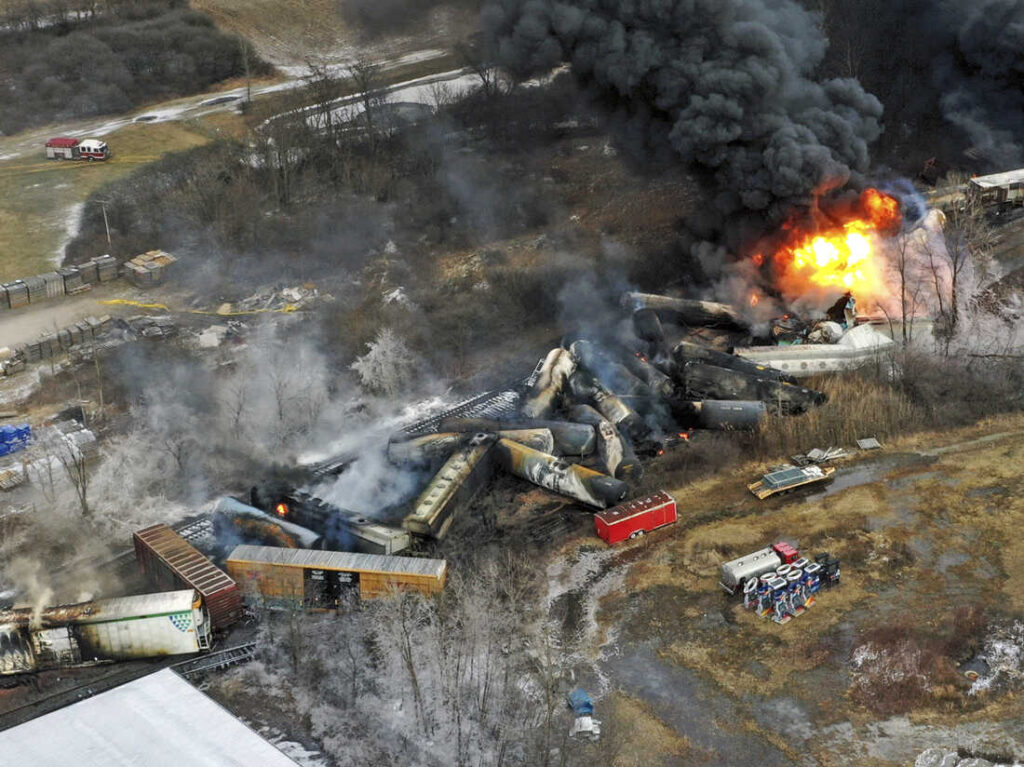West Virginia American Water said it is continuing to closely monitor water supplies along the Ohio River following the Norfolk Southern Railway train derailment in East Palestine, Ohio earlier this month.
The accident ignited tens of thousands of gallons of toxic chemicals prompting officials to evacuate nearby residents.
The chemicals, which include vinyl chloride, a known carcinogen, are responsible for killing thousands of fish and harming wildlife like coyotes, foxes and birds as well as domestic pets.
Trace amounts of hazardous chemicals have since been identified in the Ohio River, which makes up much of West Virginia’s western border.
According to Gov. Jim Justice’s office the “low levels” of butyl acrylate reached the Ohio River through its tributary, Little Beaver Creek.
Vinyl chloride has not been detected.
During a press conference Tuesday, Ohio Gov. Mike DeWine said the cleanup of the train derailment site is being done as quickly and safely as possible but expressed his surprise at a new development.
“I learned today from the Public Utilities Commission of Ohio that this train was not considered a high hazardous material train,” DeWine said. “I’m gonna repeat this. This train apparently was not considered a high hazardous material train. Therefore, the railroad was not required to notify anyone here in Ohio about what was in the rail cars coming to our state.”
DeWine said he had only just heard Tuesday that the Norfolk Southern Railway train was not required to notify state officials about the details regarding the chemicals it was transporting.
“Even though some rail cars did have hazardous material on board, and while most of them did not, that’s why it was not categorized as a high hazardous material train,” DeWine said. “Frankly, uh, if this is true, and I’m told it’s true, this is absurd, and we need to look at this and Congress needs to take a look at how these things are handled. We should know when there are trains carrying hazardous material that are going through the state of Ohio.”
In Weirton, West Virginia, officials have taken the precaution of shutting down their water intake from the Ohio River and moving to wells.
In Huntington, American Water enhanced the treatment process at the city’s intake. The company has completed installation of a secondary intake on the Guyandotte River, in the event of a need to switch to an alternate source of water. The company conducts daily tests on the water several miles upstream from the Huntington intake.
As fear grows that contamination will affect lower tributaries of the Ohio River, an official with Ohio’s Environmental Protection Agency confirmed that an initial plume of contaminants is slowly making its way down the Ohio River.
“The spill did flow to the Ohio River during that initial slug and that the Ohio River is very large and it’s a water body that’s able to dilute the pollutants pretty quickly,” said Tiffany Campbell, chief of Ohio EPA’s Division of Surface Water.
Officials are recommending that people in the immediate vicinity of the derailment drink bottled water as the cleanup and testing of water continues. Campbell said state agencies continue to closely collaborate on the monitoring of water quality.
“The Ohio EPA and other state agencies have been working with the Ohio River Valley Water Sanitation Commission (ORSANCO) to track the contaminant plume in real time,” Campbell said. “It’s moving at about a mile an hour.”
Campbell explained that ORSANCO’s tracking allows for the potential closing of drinking water intakes to allow the majority of the chemicals to pass. She said this strategy, along with drinking water treatment, including oxidation and advanced treatment like activated carbon are effective at addressing the contaminants ensuring the safety of the drinking water supplies.
“So we’re pretty confident that these low levels are not getting passed on to the customers,” Campbell said.
Asked by a reporter what else was in the plume making its way down the Ohio River, Campbell responded largely fire combustion chemicals.
“Honestly, there’s probably it’s the fire contaminant combustion materials. It’s not free product, per se, volatile organic compounds. There could be multiple but not necessarily just the remaining two that we’re seeing in the in the smaller tributaries, if that makes sense.”
She also said currently there are very “low levels” of volatile organic compounds being found in the Ohio River.
“It probably helps that it has been very diluted, and we don’t expect any higher concentrations to follow than the initial onset of the plume that we’re tracking,” she said.
Campbell said they are working with the Ohio Emergency Management Agency to begin testing for PFAS in drinking water.
The West Virginia Emergency Management Division continues to closely monitor the situation with its neighbors in Ohio.




















